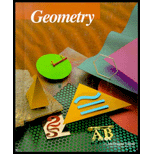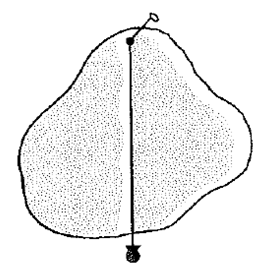
Concept explainers
a.
To poke a hole just large enough to allow the cardboard to rotate freely when pinned through the hole.
a.
Explanation of Solution
The following are the steps to poke a hole into the cardboard-
- First cut out a large irregular shaped cardboard.
- Now take one edge of the piece of the cardboard.
- Near this edge poke a hole larger enough in such a way that the cardboard should be able to rotate freely when the pinned through hole.
- The most important thing is to have a proper hole which can hold the pin as well as the whole weight of the cardboard.
b.
To find the line, tie a weighted string to the pin. Then draw on the card board the line determined by the string.
b.
Explanation of Solution
The following are the steps to poke a hole into the cardboard-
- First cut out a large irregular shaped cardboard.
- Now take the middle line of the cardboard.
- This middle line will act the central line.
- Near this middle line poke a hole larger enough in such a way that the cardboard should be able to rotate freely when the pinned through hole.
- Finally tie as weighted string to the pin.
The obtained figure is −

c.
To repeat parts (a) and (b) but use a different hole.
c.
Explanation of Solution
Similarly, another can be taken on the cardboard to repeat the parts (a) and (b).
Chapter 10 Solutions
McDougal Littell Jurgensen Geometry: Student Edition Geometry
Additional Math Textbook Solutions
College Algebra with Modeling & Visualization (5th Edition)
Intro Stats, Books a la Carte Edition (5th Edition)
Calculus: Early Transcendentals (2nd Edition)
Thinking Mathematically (6th Edition)
A Problem Solving Approach To Mathematics For Elementary School Teachers (13th Edition)
Calculus for Business, Economics, Life Sciences, and Social Sciences (14th Edition)
- Find mSWarrow_forwardSelect all solids for which the formula V = Bh applies. A. a triangular prism B. a triangular pyramid C. a square pyramid D. a rectangular prism E. a cone F. a cylinderarrow_forwardThis is my h/w ,Required to find the region of shaded sector ,I don't really know how to deal with this tasks ,so if someone could help me to understand them it would be awesome,and sorry for my poor Englisharrow_forward
- △DEF△DEF has vertices D(0, 2) and F(6, 2). If △DEF△DEF has an area of 12 square units, select all the possible coordinates for E.arrow_forwardIn quadrilateral QRST, m<R=60, m<T=90, QR=RS, ST=8, TQ=8 How long is the longer diagonal of QRST? Find the ratio of RT to QS.arrow_forward13:26 ... ← Robert F. Blitzer - Thinkin... 0,04 61 KB/d 目 polygons to create a fraudulent tessellation with discrepancies that are too subtle for the eye to notice. In Exercises 45-46, you will use mathematics, not your eyes, to observe the irregularities. B A 45. Find the sum of the angle measures at vertex A. Then explain why the tessellation is a fake. 46. Find the sum of the angle measures at vertex B. Then explain why the tessellation is a fake. =et at If se Fic SECTION 10.3 Polygons, Perimeter, and Tessellations 645 61. I find it helpful to think of a polygon's perimeter as the length of its boundary. 62. If a polygon is not regular, I can determine the sum of the measures of its angles, but not the measure of any one of its angles. 63. I used floor tiles in the shape of regular pentagons to completely cover my kitchen floor. In Exercises 64-65, write an algebraic expression that represents the perimeter of the figure shown. is be 64. le a b C 2/ If se nyarrow_forward
- Schoology → C Cportsk12.com bookmarks Sis Grades and Attendance Al Detector - the Original Al Che X GPTZero + portsmouth.schoology.com/common-assessment-delivery/start/7747152192?action=onresume&submissionId=1600790102 New Tab Home | Schoology Quadrilateral Quiz English If WXYZ is a square, and WY = 32, find XY. Round your answer to the nearest tenth. Z XY = R X Y POSSIBLE POINTS: 5 2 of 20 48 21 1 2 345678910 Next ▸ Δ ㄖㄨ All Bookmarks Schoology Help Center | PRIVACY POLICY | Terms of Use PowerSchool ©2025arrow_forwardom nearest tenth if necessary. milsum 3. છે. 9.3mm 3mm A 78-43-92 4-3) 11.7 of 72.04-11.7-= lygons 7.8 mi 60.94 blants" 9 om 6. 4.15-7 16- 32m 1.8m 4.5m % ose 4.5m as to 65m 14 represents 5 square meters.arrow_forwardThe diagonals of rhombus ABCD intersect at E. Given that BAC=53 degrees, DE=8, and EC=6 find AEarrow_forward
- Volume of Dubai Cayan Towerarrow_forward1 B-P P+1+ 2-p 4-p min(Red)=? y=x² A (P,P')arrow_forwardMI P X /courses/segura10706/products/171960/pages/611?locale=&platformId=1030&lms=Y ☆ Finish Part I: Mathematics for Elementary and Middle School Teachers Continue in the app JJ 576 Chapter 12. Area of Shapes 9. Determine the area of the shaded shapes in Figure 12.48. Explain your reasoning. 1 unit S Figure 12.48 1 unit unit and the yarn for thearrow_forward
 Elementary Geometry For College Students, 7eGeometryISBN:9781337614085Author:Alexander, Daniel C.; Koeberlein, Geralyn M.Publisher:Cengage,
Elementary Geometry For College Students, 7eGeometryISBN:9781337614085Author:Alexander, Daniel C.; Koeberlein, Geralyn M.Publisher:Cengage, Elementary Geometry for College StudentsGeometryISBN:9781285195698Author:Daniel C. Alexander, Geralyn M. KoeberleinPublisher:Cengage Learning
Elementary Geometry for College StudentsGeometryISBN:9781285195698Author:Daniel C. Alexander, Geralyn M. KoeberleinPublisher:Cengage Learning

